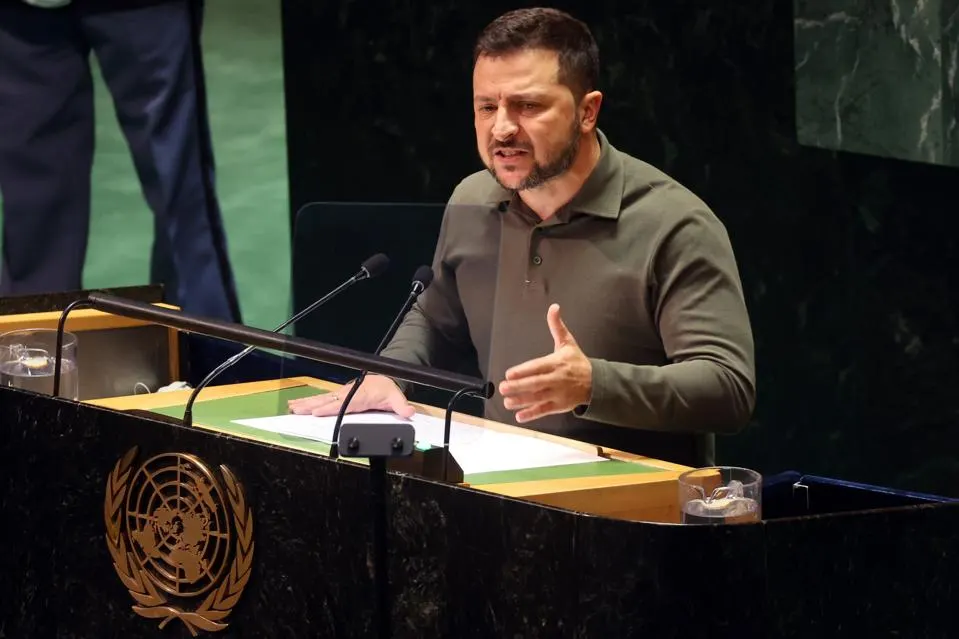Ukrainian President Volodymyr Zelensky addressed the United Nations General Assembly on Tuesday, and it has resulted in a number of controversies—including how the leader’s comments about a grain embargo resulted in a rift with its staunch supporter Poland, and how Russian diplomats attempted to block the speech from taking place.
Yet, the most notable controversy is whether the video of the speech was edited when broadcast in Ukraine. Still images from have been presented on social media that suggest Ukrainian media edited the footage to make it appear that the audience was far larger than it was.
In fact, Zelensky is purported to be seen in the audience where he had been during the remarks made by President Joe Biden earlier in the day.
However, the official video feed of the speech has been widely shared online by multiple news organizations.
There has been no official comment from the Ukrainian government on what was actually broadcast to its residents, but it would be wrong on Kyiv’s part if it in fact edited the video.
“A knee-jerk reaction would be that video manipulation by anyone is inappropriate—but in this case, it poses a dilemma,” suggested Susan Schreiner, senior analyst at C4 Trends. “Why are we holding Ukraine to a higher standard than the misinformation disseminated by Russia, China or even Trump—with his penchant for bragging about the size of his crowds on Inauguration Day?”
Seeing Is Believing… Until It Isn’t
It would also be easy to believe the narrative that Ukraine manipulated the video—but it does seem so sloppily done that it could be a case of disinformation, presented by Kremlin propagandists, especially as the actual clips are so readily available. What should be the concern is that the posts of the clips on X—the platform formerly known as Twitter—quickly went viral on Thursday with few questioning whether the edited videos actually aired in Ukraine.
In other words, was the “fake video” actually authentic, or was this a disinformation campaign?
“Many pro-Russian X accounts were retweeting this story, proclaiming their disgust of the propping up of President Zelensky,” said Amy E. Bonebright, associated professor of journalism, in the Digital Media and Journalism Department at Liberty University.
“However, a simple search using the terms edited ‘Zelensky photo’ returns the numerous times he has been targeted with altered photos and even deep-fake videos,” Bonebright continued. “So, it just seems that maybe, in some small way, Ukrainian media is waging messaging war in the same vein as the Russians have been doing for years.”
If it is part of a disinformation campaign, most users minds were already made up without doing any further investigating.
“With the bombardment of increasingly sophisticated technologies within social media platforms, it’s becoming increasingly difficult to discern fact and reality from misinformation and fiction. I fear that this will worsen, with the rise of book censorship and interference in classroom curriculum that reflects conformity and discourages thinking and exploring,” Schreiner added.
Social media has increasingly proven to be a method to spread misinformation and most people don’t seek out confirmation. Too often they trust what they see—but increasingly seeing shouldn’t result in believing.
“While ‘older’ logic would suggest that new ethical and moral guardrails need to be established—in today’s climate that seems Quixotic,” she continued. “It’s more likely however that technology will drive new forms of watermarking and other types of verification. Can technology also deliver the context—or do new tools need to be developed that enable technology to work alongside humans?
Super Spreader Of Misinformation
Given that more and more people trust what they see on social media, and rely on the platforms as their primary source of news, it has become a super spreader for misinformation and disinformation. Unfortunately, in a world where there is so little trust in the mainstream media, there is now too much trust in social media.
“We should always be on guard against propaganda, but with this kind of coverage, we are at the intersection of war news, with its inherent opportunities for false information—which can be an effective weapon—served up on social media platforms that are hard-wired to reward outrage and chaos,” warned Susan Campbell, distinguished lecturer in the Department of Communication, Film and Media Studies at the University of New Haven.
“These are worrisome and perilous times in that people are increasingly living in silos and echo chambers that mirror their so-called positions. In that environment, it’s easy for misinformation to spread like wildfire,” added Schreiner.
She noted the role of Russia and its troll farms as well as other foreign actors in driving the outcome of the 2016 elections in the U.S., as verified by many reports and accounts.
“In a more reasonable world—perhaps gravity will set in and people will slowly move towards being open to finding a middle-ground for respectful discussion within the context of agreeing to disagree,” said Schreiner. “Maybe that’s become a quixotic dream but for the sake of humanity—there needs to be an evolution in the changing relationship between people and modernity with technology.”

